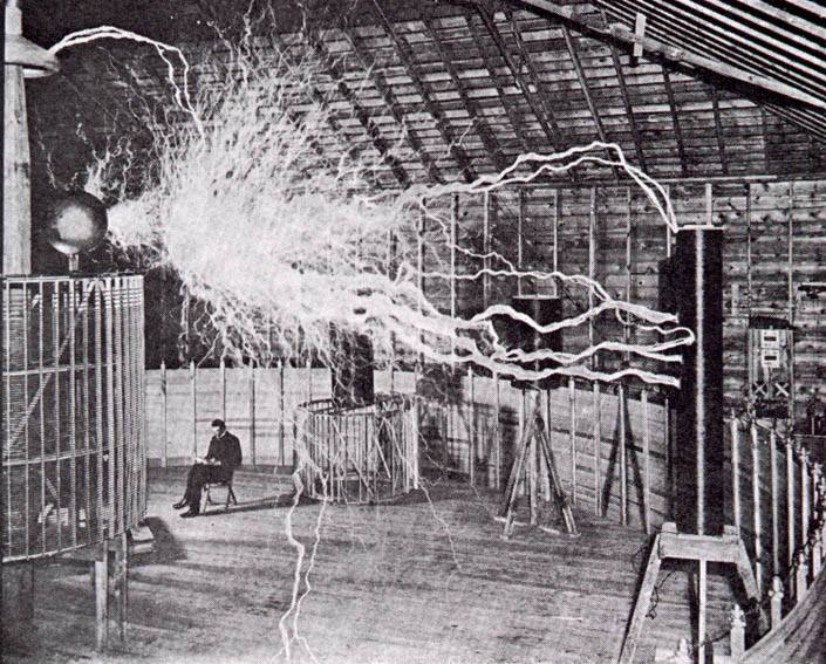
ELECTRICITY VOLUME THREE: MODERN HISTORY
How and when did we realize electricity exists, and how and when did we learn how to use it?
While Luigi Galvani and his nephew were busy zapping animals and cadavers, their fellow countryman, Alssandro Volta was making some more practical discoveries. He determined that when you put certain metals together, they would produce electricity. After much experimentation, he came up with the combination of zinc and silver as generating the most power. This is the same process that is still used today for many household batteries.

In the early 1800s, Michael Faraday discovered electromagnetic induction, or the process of producing electricity with magnets. This is the way that all household electricity is produced.
These two discoveries gave the world the ability to produce electricity in the amounts needed to make practical applications that ran on electricity. Men such as Ampere and Ohm explained the phenomenon of voltage, current and resistance, plus the basic circuits types of series and parallel.

Now that we could produce electricity in large amounts and understood circuitry, it was up to the inventors to come up with applications. One of the first big inventions that helped make the world a smaller place was the invention of the telegraph by Samuel Morse. Next came Alexander Graham Bell's telephone. Then enters one of the heavy hitters of electrical invention, Thomas Alva Edison. Among his 1,093 patents was the phonograph, movie projector, relay telegraph, and, of course, the light bulb which changed the world forever.
Another heavy hitter in the world of electricity was Nikola Tesla. Tesla was an incredibly intricate and interesting man that is full of controversy. He was somewhere between a genius and a mad man. He got his start working in Edison's lab at Menlo Park, but became frustrated with Edison's technique. He once derisively said of Edison "I he were try to find a needle in a haystack, he would start at the top of the stack and check each piece of straw, one by one until he found it". It was true, once Edison set himself on a path to discovery, he would methodically try one thing after another, making a slight change each time until he had what he was looking for. Tesla, on the other hand, would set his mind to something and would figure everything out in his head before he actually built it. Two of his greatest inventions are the transformer and the alternating current motor.
Electrical production was on the verge of great things and this was one of those defining moments. Edison, was a firm believer in direct current, while Tesla was a proponent of alternating current. The main advantage of alternating current is it lends itself to transforming voltages up and down with the use of transformers. This gives us the ability to transform electricity to very high voltages so it can be sent over great distances, then transformed back down to safer voltages at the point of use. In today's hind sight, that is such a remarkable advantage over DC that, I, for one, can't imagine why Edison fought so hard for direct current. In a ploy to convince the public that DC was better than AC, Edison started a smear campaign against DC. He said that AC was very dangerous. To prove this point he invented the electric chair. Somehow people dying from AC was supposed to be more dangerous that people dying from DC (i.e. lightning).

Anyway, Tesla's system of alternating current won out. George Westinghouse, who had already made a fortune from inventions for trains, saw an opportunity with Tesla's AC inventions. He bought Tesla's motor and transformer and hired Tesla to work for him. Today, two of the biggest names in the electrical industry Westinghouse and Thomas Edison's General Electric, remain at the top of their industry.

As a sideline. Tesla went on to invent the Tesla coil, which is the main component of every radio broadcast station today. Only by patent rights has Marconi been acknowledged as the inventor of the radio. The same can be said for Edison who had a working model of the telephone before Bell, but lost on the legal front and patent office. Tesla also claims to have invented the Xray and the vacuum tube amplifier, but never received credit for those. Finally, Tesla claimed to have invented a death ray that could down 10,000 airplanes from 250 miles or split the Earth. Another claim was the idea that he could generate electricity with a generator that used cosmic rays to produce unlimited power. Unfortunately, investors could never quite dump enough money into those, and other incredible inventions so they never came to fruition. When he died, the FBI who was interested in his death ray, raided his apartment and confiscated all his papers, however, his nephew got there first and supposedly took some documents and destroyed others helping to fuel endless debate as to whether Tesla was really a genius or madman.


0 Comments:
Post a Comment
<< Home